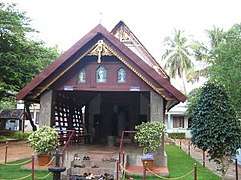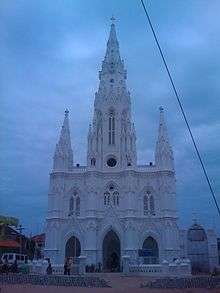Christianity in Kanyakumari district
Christianity in Kanyakumari district is its second largest religion. The Catholic Church has about 400,000 followers, while the Protestant groups have about 200,000 members.[1] Currently, Christians are a minority community in Kanyakumari District comprising 46% of the population.

Christianity is said to date back to the 1st century CE.[2][3] According to the tradition, St. Thomas, one of the twelve apostles, landed on the Malabar Coast (Kerala) in 52 CE and introduced Christianity.[2][4][3] It is believed he built St. Mary's Church in Thiruvithamcode in 63 AD.[4] During the colonial period Italian, British, Dutch and Portuguese Christians came to Tamil Nadu.[3]
Denominations
The Roman Catholic Church (Latin Rite), the Church of South India, The Salvation Army Church, the Syro-Malabar Catholic Church, the Jacobite Syrian Christian Church, the Syro-Malankara Catholic Church, the Malankara Orthodox Syrian Church, the Evangelical Church of India, the Pentecostals, and other evangelical denominations are there. The Latin Rite of Roman Catholic Church is the oldest and the largest and has a homogeneous presence throughout the district. The second-largest church by number of members is the Church of South India.The vast majority are either members of the Latin Rite Roman Catholic Church or the Church of South India.
Roman Catholic Church

In 1542, St. Francis Xavier came to Kanniyakumari District.During the 16th century, he converted thousands of fishermen between Ramanathapuram and Kanyakumari to Catholicism. Between 1543 and 1544 Francis established forty-five churches in the coastal areas of Travancore.[1]
Church of South India
The British East India Company, helped Protestant churches to grow in the Kingdom of Travancore and Madras Presidency. Conversions took place in Kanyakumari and Tirunelveli from among the Nadar and Paraiyan communities by the work of the Church Missionary Society and London Missionary Society. In 1818, 3000 members of the Nadar caste were said to have embraced Christianity.[1]
During the 18th century, on the request of German missionary Rev. J. C. Kohlhoff, William Tobias Ringeltaube came to Travancore.[5] Over a period of ten years, Ringeltaube succeeded in building his mission. The first church was built at Mylaudy in September 1809. Many churches and schools were established in many more villages. A large church was built in Nagercoil that later became the home church for the CSI diocese in Nagercoil. The mission moved from Mylaudy to Nagercoil. Boarding schools were started for girls and education for women gained momentum. Even non-Christian students received education. A printing press was started by his mission in 1821. By 1838 a medical wing of the mission was established.[5]
The Syro-Malabar Catholic Church
In 1996, the Syro-Malabar Catholic Church created its first `Diocese of Thuckalay`in Kanyakumari district, which was under the Syro-Malabar Catholic Archdiocese of Changanassery in Kerala until then.[6] The same year the newly established `Diocese of Marthandam split from the Archdiocese of Trivandrum in Kanyakumari district.[7]
Caste system
During the period of Kingdom of Travancore, the present day Kanyakumari district was under the control of the Kingdom. It was caste-based. Those who belonged to lower castes were denied education, choice of occupation and basic dignity. The women of the lower castes and untouchables were not allowed to cover their breasts and they had to pay the mulakkaram (breast tax) to the Brahmin king if they wanted to cover their breasts. The tax was amount depended on their breast size.[8][9][10][11][12] A woman baring her chest to Nambudhri brahmins was considered a sign of respect, by both males and females from the lower castes.[13][14] Higher-class women covered both breasts and shoulders, whereas lower castes including Nadar and Ezhava women were not allowed to do so, to show their low status.[14][15] Uneasy with their social status, many Nadars embraced Christianity, and started to wear long cloths. When many more Nadar women turned to Christianity, many Hindu Nadar women adopted the Nair breast cloth.[15][12][8][9]
From 1813 to 1859 laws were enacted and repealed by the Kingdom regarding the upper cloth issue.[16][17] During this period waves of violence and agitation continued between the higher and lower castes. Due to the rebellion of lower castes, on 1859 the kingdom permanently permitted lower caste women to wear garments on their torsos.[12][8]
The missionaries and the church helped the lower castes to break some of the shackles that had bound them for centuries. Through the help of the Church and missionaries, the breast tax and the system of Oozhiyam (hard work for little or no pay) was abolished by the Kingdom.[18][9][8][12]
Notable churches
- CSI Home Church, Nagercoil
- Curusadi St. Antony's Church
- Marthandam CSI Church
- Our Lady of Ransom Church, Kanyakumari
- Periyanayaki Shrine, Thiruvithancode
- St. Francis Xavier's Cathedral, Kottar
- St. Sebastian Church, Madathattuvilai
- St. Antony's Church, Chemmanvilai
- St. Mary's Church, Thiruvithamcode
References
- "Hindu Christian Communalism; Analysis of Kanyakumari Riots". www.ibiblio.org. Retrieved 13 November 2019.
- Asthana, Deepti. "Divine intervention". @businessline. Retrieved 13 November 2019.
- Hays, Jeffrey. "CHRISTIANS IN INDIA | Facts and Details". factsanddetails.com. Retrieved 13 November 2019.
- Sathyendran, Nita (16 May 2013). "The church that St. Thomas built". The Hindu. ISSN 0971-751X. Retrieved 13 November 2019.
- Kent, Eliza F. (2004). Converting Women: Gender and Protestant Christianity in Colonial South India. Oxford University Press. p. 43. ISBN 9780195165074.
- "Syro Malabar Thuckalay Eparchy". www.syromalabarchurch.in. Retrieved 13 November 2019.
- "EPARCHY OF MARTHANDAM". www.catholicate.net. Retrieved 13 November 2019.
- "Breast Tax and the Revolt of Lower Cast Women in 19th Century Travancore". 17 May 2019. Retrieved 15 November 2019.
- "Travancore parallel: the fight to wear an upper garment". The Indian Express. 18 October 2018. Retrieved 15 November 2019.
- "The woman who cut off her breasts to protest a tax". 28 July 2016. Retrieved 14 November 2019.
- "The CBSE Just Removed an Entire History of Women's Caste Struggle". The Wire. Retrieved 14 November 2019.
- "A struggle for decent dress". The New Indian Express. Retrieved 15 November 2019.
- Unni Nair, Supriya. "Dress code repression: Kerala's history of breast tax for Avarna women". the news minute. Retrieved 13 November 2019.
- "Re-writing History, Saffronising Education: Remembering Nangeli Lest Government Makes Us Forget". NewsClick. 19 March 2019. Retrieved 13 November 2019.
- "Travancore parallel: the fight to wear an upper garment". The Indian Express. 18 October 2018. Retrieved 13 November 2019.
- Cohn 1996, p. 140.
- Ponnumuthan 1996, p. 109.
- MacKenzie, Gordon Thomson (1901). Christianity in Travancore. Trivandrum : Printed at Travancore Govt. Press.